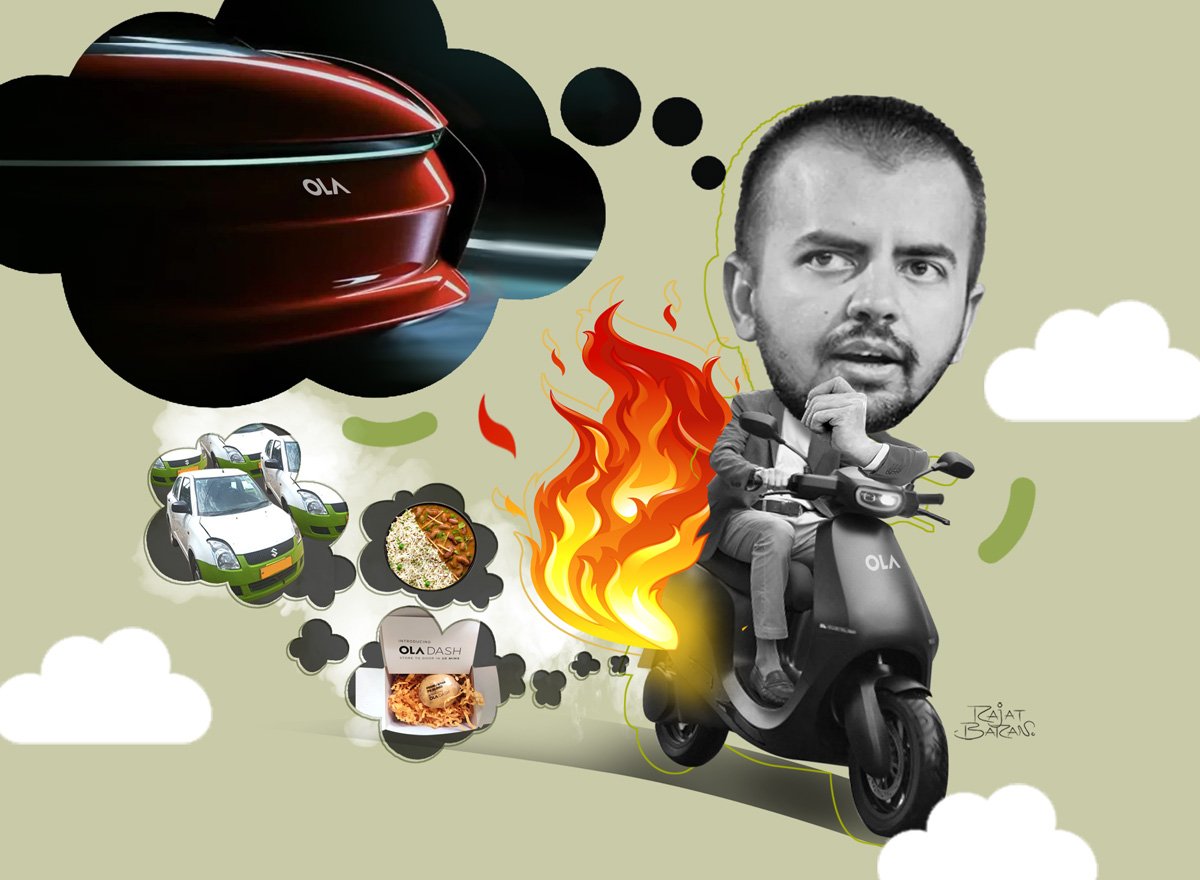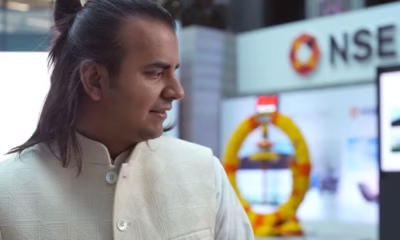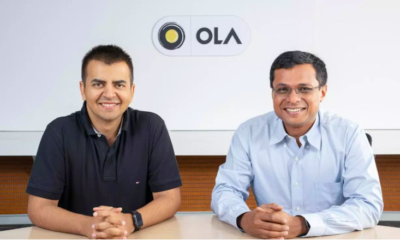Trends
Yet Another Jolt To Ola. N Balachandar, Group Chief People Officer Quits. Why Does Almost Everything Feel Like GO-La At Bhavish Aggarwal’s Ola?
Published
10 months agoon

What’s the deal with Ola? The company seems to be stuck in a perpetual game of musical chairs when it comes to senior executives. The latest to jump ship is N Balachandar, Ola Group’s Chief People Officer, who resigned in November.
Balachandar, a seasoned HR professional, joined Ola Electric as its CHRO in May 2021 and was later elevated to a group-level role. He spearheaded HR for Ola Cabs (now Ola Consumer), Ola Electric, and Krutrim, the group’s AI venture.
His departure wasn’t exactly a bolt from the blue. Sources suggest that the decision was in the works for months, with discussions between Balachandar and Bhavish Aggarwal taking place well in advance. He has since ventured into entrepreneurship, setting up a management consultancy firm.
Still, Balachandar’s exit is just one of many high-profile resignations at Ola this year.
In October, Siddharth Shakdher, Chief Business Officer of Ola Consumer, resigned within nine months of joining and transitioned to Paytm as its Chief Marketing Officer and Business Head. Around the same time, Mahesh Alanthat, Vice President and Head of Sales at Ola Electric, left after a short stint that began in March 2023.
Earlier in May, Kartik Gupta, Ola’s Chief Financial Officer, also stepped down, closely followed by Hemant Bakshi, CEO of the mobility business under Ola’s parent company, ANI Technologies.
Grey Clouds Over Ola
These leadership exits come at a turbulent phase for Ola. The company’s electric two-wheeler business, Ola Electric, has seen a decline in market share, a rise in customer complaints, and a drop in stock prices. The company’s stock recently fell 2.24%, closing at ₹93.98 on the BSE.
In a bid to cut costs, Ola Electric laid off 300-400 employees across departments, particularly in manufacturing and supply chain management. The ride-hailing business isn’t faring much better, with Ola losing ground to younger competitors like Rapido and Namma Yatri.
Additionally, Ola has exited international markets in Australia, New Zealand, and the UK to focus on profitability.
Ola’s employee attrition rate also paints a worrying picture, standing at 44.25% in FY24. High turnover and frequent leadership changes often indicate deeper organizational issues.
Meanwhile, the electric vehicle market, once a promising growth avenue for Ola, has turned fiercely competitive. Legacy players like Bajaj Auto and TVS Motor are proving to be formidable rivals. With customer trust waning and market dynamics shifting, Ola faces an uphill battle to retain its position as an industry leader.

Why Can’t Ola Keep Its Top Brass?
The latest exit paints a picture of a man who’s part visionary, part dictator, and entirely polarizing.
Bhavish Aggarwal, often seen in his trademark kurta, has been described as cocky, brash, and confident. Confidence is great, sure, but what happens when it morphs into a full-blown “my way or the highway” attitude? Well, you get a string of top-level resignations, a workforce walking on eggshells, and an ever-growing pile of HR nightmares.
Working with Bhavish isn’t for the faint-hearted. According to insiders, he sets the bar so high it might as well be on Mars—though Elon Musk is already claiming dibs there. His expectations, often bordering on the unrealistic, are paired with timelines so tight they’d make a Swiss watch blush.
Employees are pushed to deliver at breakneck speed, and those who can’t keep up? Well, they’re shown the door—or they leave before being shoved. Burnout, high attrition rates, and a culture of fear seem to be the collateral damage of Bhavish’s relentless pursuit of “ambitious goals.”
Command and Control
Decision-making at Ola appears to be less about collaboration and more about Bhavish’s gut instinct. Feedback? Alternative perspectives? Those might be luxuries for another company, but at Ola, the CEO’s vision is the law.
And let’s not forget the infamous temper. Tales from past and present employees often feature Bhavish losing his cool, complete with Punjabi epithets and a few choice words about teams being “useless.” Apparently, loyalty and trust are earned the hard way at Ola—by enduring verbal smackdowns and still showing up the next day.
Bhavish has been unapologetic about his management style. He’s famously quipped, “Not everybody is a fit for our culture” and “I’m not here to have a nice time.”
Fair enough, but here’s a reality check: a company’s culture isn’t just about its CEO’s whims—it’s about the people who bring the vision to life. Thus, Ola’s revolving door of executives and a demoralized workforce, we ask, is the problem the culture or the one setting it?
The Product… And So Many Problems
Even if Bhavish’s management style were excusable (it’s not), Ola’s product history isn’t exactly helping his case. Remember the scooters that caught fire? Or the deluge of customer complaints?
Revolutionizing mobility is great, but maybe focus on not sending your product—or your workforce—up in flames first.
One of Aggarwal’s more recent brush-ups with controversy revolves around his criticism of LinkedIn for referring to him using non-binary pronouns. For a man who already wears his views on Indian culture proudly, this was a step too far. Aggarwal lashed out, calling it a
“Western ideological imposition” and expressing concern over the erosion of India’s cultural identity.
It’s a bold stance, no doubt, but it has sparked widespread debates about inclusivity, cultural sensitivity, and how global platforms interact with local traditions. While some hailed him as a defender of Indian values, others labeled his reaction as unnecessary theatrics.
The Great Work-Life Balance Debate
If you thought weekends were sacred, think again. Bhavish Aggarwal has questioned the very concept of Saturdays and Sundays as days off, calling them a “Western cultural import”. According to him, India’s traditional lunar calendar dictated holidays, and the industrial revolution brought in the notion of the weekend.
But let’s face it: most people don’t want a history lesson when they’re trying to enjoy their chai on a Sunday morning. His dismissal of work-life balance as a modern luxury doesn’t exactly resonate with a workforce already dealing with burnout and unrealistic expectations.
And then there’s his infamous scheduling—meetings at 1–3 a.m., anyone? For Aggarwal, the grind never stops, and he expects his team to match his unrelenting pace. Unsurprisingly, this hasn’t done wonders for employee morale.
A Twitter War to Remember
Aggarwal’s knack for stirring the pot isn’t limited to internal company matters. Who can forget his public spat with comedian Kunal Kamra? Kamra, ever the provocateur, pointed out the sheer number of Ola scooters lining up for service—a jab that hit too close to home.
Aggarwal, never one to back down, responded in kind, leading to a Twitter exchange that was as entertaining as it was cringe-worthy. The whole of India tuned in, popcorn in hand, to pick sides in this CEO-vs-comedian showdown. Spoiler alert: neither came out looking particularly great.
The “Elon Musk of India” Label
Aggarwal has often been compared to Elon Musk, a moniker that seems equal parts flattering and far-fetched. Sure, both are ambitious, polarizing, and not afraid to ruffle feathers. But while Musk’s controversies are often overshadowed by groundbreaking innovations, Aggarwal’s are overshadowed by service complaints, scooter fires, and a slew of regulatory notices.
Case in point: Ola Electric recently received a show-cause notice from the Central Consumer Protection Authority over alleged consumer rights violations, misleading advertisements, and unfair trade practices. The notice, delivered on October 7, 2024, is just the latest in a string of issues plaguing the company.

The Verdict. Do Bhavish Aggarwal’s Claims Hold Up?
Bhavish Aggarwal, Ola Electric’s dynamic and often polarizing CEO, has never been shy about making bold proclamations. Whether it’s about building the world’s largest EV factory, revolutionizing electric mobility in India, or becoming the “largest EV company in the world,” Aggarwal’s claims often grab headlines. But how much of what he says stands up to scrutiny?
Let’s take a closer look.
1) The Ola Electric Car. Ambition vs. Reality
On August 15, 2022, Aggarwal announced plans to launch an Ola Electric car with a range of over 500 km and acceleration from 0–100 km/h in less than four seconds—by 2024.
For an EV company still in its infancy, this sounded overly ambitious, especially compared to industry stalwarts like Tata and Mahindra, who have taken years to develop fully functional EV platforms.
At the time of the announcement, Ola Electric had yet to test its E4W (electric four-wheeler) platforms. Fast forward to 2024, and the reality is well, different. Not only has the company shelved its four-wheeler plans, but it also falls far short of the lofty production goals Aggarwal laid out.
In 2022, Ola claimed its FutureFactory would produce 1 million electric four-wheelers, 10 million electric two-wheelers, and 100 GWh of battery cells annually. As of now, the company has yet to reach even 1 million E2Ws and has scaled back its battery production plans to 20 GWh.
Aggarwal’s penchant for grandiose claims might serve as effective marketing, but it also raises questions about accountability and whether such promises are more about hype than substance.
2) Is Ola Electric the Largest EV Company?
Aggarwal has frequently described Ola Electric as the “largest EV company in the world (excluding China).” This phrase alone raises eyebrows. Why exclude China—a country that accounts for nearly 60% of global EV sales? Ignoring such a massive competitor skews the picture, and even without China, the claim doesn’t entirely hold up.
For instance, Tata Passenger Electric Mobility Ltd. (TPEML) and Mahindra Electric Automobile Ltd. (MEAL) both have higher valuations than Ola Electric, which stands at approximately INR 58,699 Cr ($7 billion). Tata and Mahindra are valued at around INR 82,000 Cr ($10 billion) each.
Moreover, Aggarwal’s own presentation contradicted the claim, showing Ola as the fifth-largest EV company by market valuation. The cherry-picking of data—excluding non-publicly listed companies—makes the assertion even murkier.

3) The Revenue Claim. 4th Largest EV Company in the World?
Aggarwal has also claimed that Ola Electric is the fourth-largest EV company globally by revenue. However, even when excluding China, this doesn’t hold water.
For example: Lucid Motors (US): Revenue of $618 million (April 2023–March 2024).
Polestar (Sweden): Revenue of $890 million in the same period.
Ola Electric’s revenue of $600 million places it behind both. Curiously, Polestar—a significant player—is absent from Aggarwal’s presentation, possibly because its parent company, Geely, is a Chinese OEM.
Additionally, while Aggarwal claims this achievement was accomplished in just three years, Ola Electric was incorporated in 2017. The journey to its current revenue involved years of R&D and infrastructure development, which Aggarwal conveniently overlooks.
4) Is Ola’s Gigafactory the First to Produce Cells in India?
Vishal Chaturvedi, Ola Electric’s business head, stated that Ola has built India’s first lithium-ion cell manufacturing facility.
This claim doesn’t hold up. Bengaluru-based Log9 Materials claimed this milestone in 2023, well before Ola Electric’s facility was operational.
In April 2023, Log9 Materials commercially launched India’s first indigenously made lithium-ion battery cell, manufactured at its Bengaluru facility. These were the first large-format, mass-produced cells to receive BIS certification in India by April 2024.
On the other hand, Ola Electric’s Bharat 4680 cells received BIS certification on May 13, 2024—over a year after Log9’s achievement.
5) Is the Ola Gigafactory’s 100 GWh Capacity Actually True?
Aggarwal reiterated his ambition of building the world’s largest 100 GWh gigafactory in India.
While this ambition is commendable, it’s far from reality—at least for now. As per regulatory disclosures, Ola Electric has no concrete plans to expand beyond a 20 GWh capacity by the end of 2026.
This claim isn’t entirely false but is undoubtedly a stretch. Aggarwal’s grand vision seems more like a long-term goal rather than a near-term reality.
6) The Bodhi AI Chip.
Ola’s Bodhi AI chip will process 64,000 frames per second, outperforming the competition’s 55,700 frames per second by 33% in efficiency. It is slated for launch in 2026.
While the announcement is impressive, the claim raises several questions:
Designing and manufacturing a cutting-edge AI chip is a highly complex and resource-intensive process. Even established chipmakers like Intel have struggled to compete with Nvidia and AMD in the AI space.
Intel’s Gaudi AI chip, despite promising specs, hasn’t matched Nvidia’s H-series chips. This highlights the challenges new entrants face in this domain.
Ola’s plan to remain fabless (outsourcing chip manufacturing to third-party foundries) adds another problem. The company has yet to finalize the foundry for its chips, which casts doubt on its ability to deliver by 2026.
Additionally, Ola’s claim of outperforming competitors is based on raw performance metrics that don’t account for other critical factors, such as software integration, energy efficiency in real-world scenarios, and ecosystem support. For context, Apple took over a decade to perfect its proprietary silicon chips for its devices—and those were designed for specific hardware.

The Take
So, is Bhavish Aggarwal the “Elon Musk of India”? Perhaps, if you squint really hard. But for now, he seems more like a CEO whose vision and ambition are overshadowed by his controversies and questionable leadership style.
India loves a disruptor, but even disruptors need to keep their wheels on the ground—or, in this case, their scooters out of the service queue.
Aggarwal’s ambitious claims are characteristic of his leadership style, which has always leaned toward aggressive growth and bold marketing.
However, the gap between his rhetoric and actual deliverables raises questions about accountability.
Startups are no strangers to ambitious targets and subsequent pivots. It’s part of the game. However, Aggarwal’s claims often go beyond optimism and veer into the realm of exaggeration.
While hype can be an effective short-term strategy, it risks eroding trust in the long run, particularly now that Ola Electric is a publicly listed company. Shareholders and consumers alike expect transparency and credibility—something Aggarwal’s approach often lacks.
Ambition is essential in a competitive market, but so is accountability. For Ola Electric to truly lead the EV revolution, it needs more than bold claims—it needs to deliver on them. Until then, Aggarwal’s headlines may generate buzz, but they’ll also invite scrutiny.
For a company gearing up for an IPO, frequent leadership exits, high attrition rates, and stiff competition raise questions about Ola’s ability to sustain its growth story.
Perhaps it’s time for Bhavish to swap the kurta for a pair of listening ears—and a bit of humility.
Ola may still have the wheels to drive forward, but can it steer clear of these “fiery” potholes?




